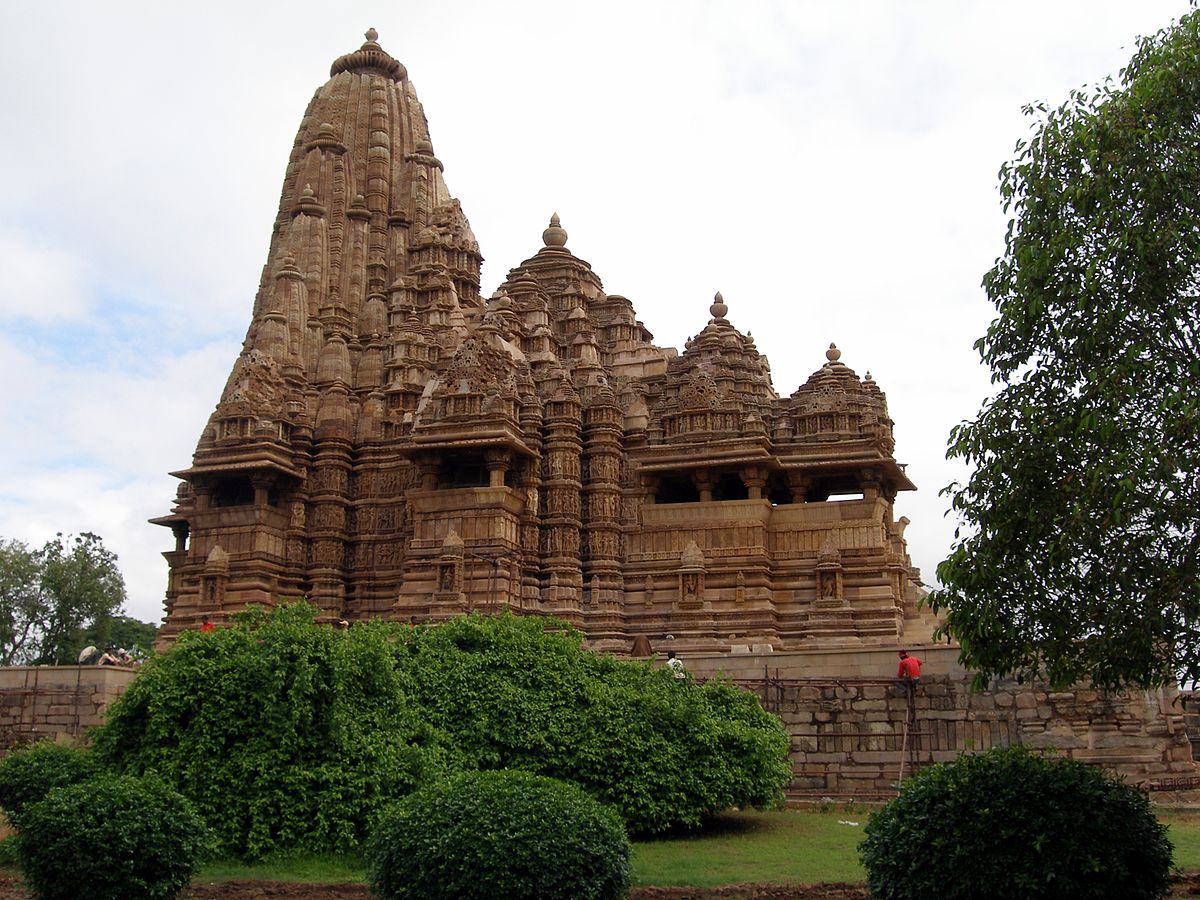Kandariya Mahadeva Temple is the largest temple in western group of temples of Khajuraho and is dedicated to the Lord Shiva, the ascetic who dwells in a mountain cave (Kandara). So its name consists of words Kandara and Mahadeva, another name of Lord Shiva. The main spire or Shikhara rises to 30.5 m to depict Mount Meru, the holy mountain of Shiva and is surrounded by 84 miniature spires. 1 This cluster around the central peak creates the effect of a mountain range. There is a marble Shiva-linga in the inner sanctum. Approximate location of the temple is 24.853017' N, 79.919632' E (WGS 84 map datum) and sits just to Lakshmana temple and about 250 m to the west of Visvanatha Temple. The appearance of the temple is deceptive as it seems to be carved out of a solid piece of stone. The Kandariya Mahadev Temple meaning “the Great God of the Cave” is the largest and most ornate Hindu temple in the medieval temple group found at Khajuraho in Madhya Pradesh, India. It is considered as one of the best examples of temples preserved from the medieval period in India. Shiva, in the form of a linga, is the chief deity in the temple deified in the sanctum sanatorium. The name ‘Kandariya’ means “cave” and ‘Mahadeva’ is another name for Shiva. The temple is decorated with more than 900 stone carvings and the stones are set without mortar; most of it on the exterior surface of the temple as the interior decoration is sparse.
Kandariya Mahadeva temple is located in Khajuraho Village, Madhya Pradesh. The temple complex is spread over an area of Six square kilometers (2.3 sq m). It is in the western part of the village to the west of the Vishnu temple Kandariya Mahadeva Temple is artistically and architecturally the most perfect and finest temple in India. It measures about 30.5 m each in length and height and 20 m in width. The temple architecture includes analysis of temple plan, elevation, the ceiling architecture; material used and sculpture contents of the temple. This temple comprises all essential elements of nagara style of architecture which is mostly found in temples of north India. It consists of Mukhmandapa (entrance porch), followed by a mandapa (assembly hall), mahamandapa (dance hall), antarala (vestibule) and garbha-gariha (sanctum sanctorum) enclosed by an ambulatory with transepts on the sides and on the rear and on elevation. This temple can be graded as the grandest and loftiest of temple cluster at Khajuraho, not merely as its colossal height and length, but also on account of the rhythmic crescendo of architectural perfected by the doyens of yore.3 The temple is built on a high Jagati (platform) approached by a fleet of steps. Its total height is 116.5 feet above the ground and 88 feet above its own floor.
Do:
Do pray your Ishta Devata before the pilgrimage to Temple.
Do contact Temple Devasthanam information center for inquiry, temple information and for Pooja details, etc.
Do reserve your travel and accommodation at Temple well in advance.
Do a bath and wear clean clothes before you enter the temple.
Do concentrate on God and Goddess inside the temple.
To maintain silence and recite Om Namahsivaya or your Istamantram to yourself inside the temple.
Do observe ancient customs and traditions while in Temple.
Do respect religious sentiments at Temple.
Do deposit your offerings in the hundi only.
Don'ts:
Do not come to Temple for any purpose other than worshipping of God and Goddess.
Do not smoke at Temple.
Do not consume alcoholic drinks at Temple.
Do not eat non-vegetarian food in the Kshetram.
Do not approach mediators for quick Darshanam. It may cause inconvenience to others.
Do not carry any weapon inside the temple.
Do not wear any head guards like helmets, caps, turbans, and hats inside the temple premises.
Do not perform Sastanga Pranama inside the Sanctum Sanctorum.
Do not take much time while performing Sparsa Darshanam to God in Garbhagriha.
Do not buy spurious prasadams from street vendors.
Do not encourage beggars at Temple.
Do not spit or create a nuisance in the premises of the temple.
